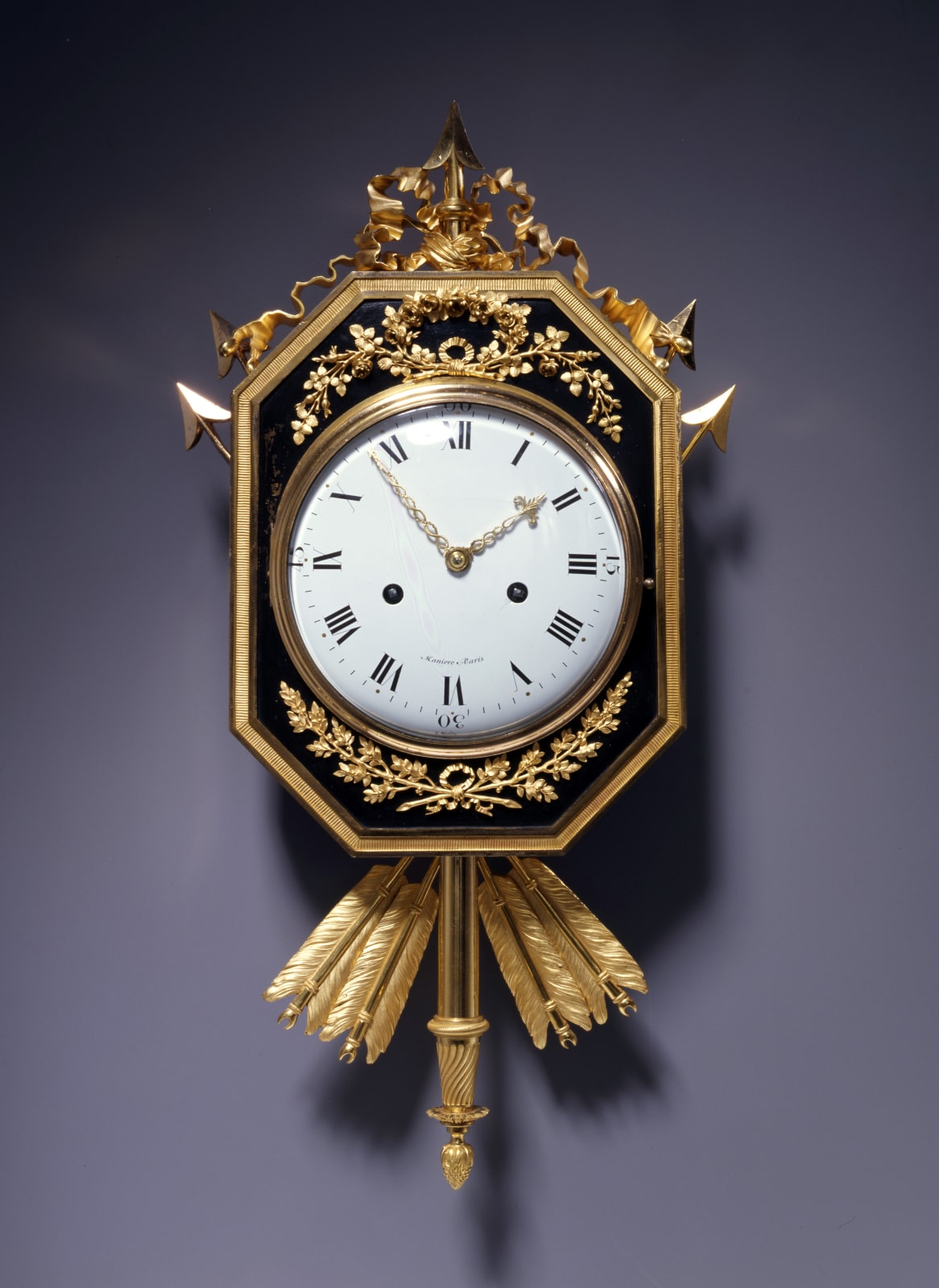Manière
A very fine Directoire gilt and patinated bronze cartel clock of eight day duration, signed on the white enamel dial Manière à Paris, the dial with Roman and Arabic numerals and a fine pair of pierced gilt brass hands for the hours and minutes. The movement with anchor escapement, silk thread suspension, striking on the hour and half hour, with outside count wheel. The octagonal-shaped case with plain circular bezel bordered above and below by ribbon-tied foliate branches, the case surmounted by a central ribbon-tied arrow head flanked either side by a pair of smaller arrow heads to the corners with their feathers projecting below and flanking a central arrow shaft terminal
Paris, date circa 1795
Height 62 cm, width 31 cm.
This known case model was also produced on a smaller scale when it formed part of a table clock, known either as A Gros Amour or Eros à la Torche, which featured a patinated bronze winged Cupid with flaming torch standing to the left of the clock proper and set upon a gilt bronze mounted rectangular marble base. One of these examples, which as here was fitted with a movement by Charles-Guillaume Hautemanière, known as Manière (d. after 1812) and likewise signed on the dial Manière à Paris, is now in the Hermitage Museum, Saint Petersburg. It was supplied by the marchand-mercier Xavier Labensky on 28th October 1798 as part of a large consignment to Tsar Paul I to furnish his newly built palace of Saint-Michel, Saint Petersburg, (illustrated in Iouna Zek, "Bronzes d'Ameublement et Meubles Français Achetés par Paul Ier pour le Château Saint-Michel de Saint-Pétersbourg en 1798-1799", in " Bulletin de la Société de l'Histoire de l'Art Français", 1994, p. 147, pl. 10). In her discussion of the clock, Iona Zec, ibid. p. 145, notes that the case model belonged to the marchand-mercier Martin-Eloi Lignereux (d.1809) of rue Taitbout, in view of the fact that his name appears on the dial of another identical example (illustrated in Jean-Dominique Augarde, in "Les Ouvriers du Temps", 1996, p. 201, pl. 163). Interestingly the latter was either owned by the duc de Saxe-Teschen (Marie-Antoinette's brother-in-law) or by his adopted son, l'archiduc Charles. Lignereux's name is significant since Manière originally worked extensively for his predecessor the marchand-mercier Dominique Daguerre (d. 1796), for whom he supplied work valued at the substantial sum of 920,000 livres between 1778-92. Daguerre's business was subsequently acquired by Lignereux, which in turn was purchased by the renowned bronzier Pierre-Philippe Thomire (1751-1843) in 1804.
Manière's clocks were regarded as much as for their mechanical excellence as for the aesthetic value of their cases, many of which were made by such eminent bronziers as Pierre-Philippe Thomire, François Rémond, Jean-Baptiste Osmond, Claude Galle, Edme Roy and François Vion. It is possible that the present case was made by Thomire after a model by the sculptor Etienne-Maurice Falconet. In her discussion of Eros à la Torche, Zec notes that the model was at one time believed to have been by Falconet and was possibly the one referred to in a later letter by Thomire to Nicolas Demidoff, 1823.
Manière, the son of another Parisian maître-horloger, Jean-Pierre (d. after 1789), was received as a maître in 1778, at which date he was established at rue du Four-Saint-Honoré. By 1781 he had moved to rue des Prouvaires and by 1789 to rue Mercier. He later moved to rue Christine, 1806 and four years later was recorded at rue Bertin-Poirée. Examples from his outstanding career can be found in many public collections including the Châteaux de Fontainebleau and Versailles, in Paris at the Musée des Arts Décoratifs and Musée Nissim-de-Camondo as well as the Patrimonio Nacional in Madrid. In addition the Museum of Decorative Arts in Prague, the Palazzo del Quirinale in Rome and Palazzo Reale in Turin, as well as the Hermitage Museum, Saint Petersburg and Woburn Abbey, Woodstock, Oxfordshire also own examples from his oeuvre.
